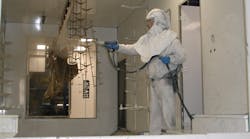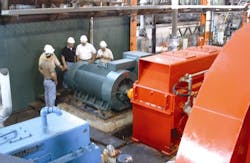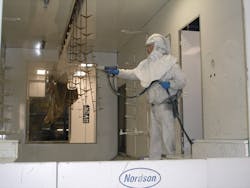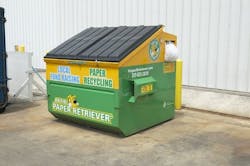As part of Corporate Americas eternal quest to improve the bottom line, companies have long sought and implemented strategies and technologies that are now labeled green. Efforts to reduce energy consumption, minimize waste and improve performance tend to have environmental benefits. Now that sustainability as a strategy is coming into fashion, the push is on to expand and intensify the opportunities to save our planet and to publicize these efforts as a demonstration of good corporate citizenship. But is this just a public relations ploy, or can the tactic actually improve profitability?
|
Sustainability is about carefully managing Earths finite natural resources to sustain a quality of life for ourselves and future generations. Rapid population growth is one of the most compelling arguments for it. The global population, presently about 6.6 billion, is expected to increase by 50% within 43 years.
In manufacturing terms, exponential population growth means more factories taking up more land, using more raw materials, and allowing more emissions and waste into the environment. Demand for products and services will grow, but the availability of supplies isnt guaranteed. Competition for Earths finite resources will heat up and its easy, yet unsettling, to imagine the socio-economic and political consequences.
A variable-speed drive saves energy that the La Union sugar mill in Guatemala is able to sell for additional revenue of $158,480 per harvest season. Source: Rockwell
To achieve and maintain world-class sustainable manufacturing, you need continuous improvement not just of your capital assets but the utilization and return on your raw materials, utilities and human resource assets as well, says John Blanchard, principal analyst for CPG industries at ARC Advisory Group. Manufacturing companies should recognize that it will become increasingly difficult for manufacturing operations to drive new growth and margin without considering manufacturing sustainability in their business decisions.
The benefits are practical as well as financial. Blanchard explains, Maximizing the utilization of assets always brings a return on investment. If you can bring a packaging line from 50% efficiency to 80% efficiency without buying new equipment or using more energy, then you have reduced the cost per unit of product and demonstrated one of many approaches toward achieving world-class sustainable manufacturing.
Heres how some popular green strategies are paying for themselves.
Improve air quality
Weve seen a 21% reduction in ozone levels nationwide since 1980, and federal, state and local governments are working together to continue this trend. EPA is proposing to revise and strengthen U.S. air quality standards for ground-level ozone based on the most recent scientific evidence about its health effects. Whats not improving is the concentration of greenhouse gases in the atmosphere mostly CO2 from combustion of coal, oil and gas.
Moving from a liquid painting process to powder coating annually saves Tennant Company $33,000 per year, reducing water pollutants by nearly 36,000 pounds and cutting water use by 3.7 million gallons. Source: Tennant
Regardless of where one stands on its relationship to global warming, resistance may be futile. Nearly a third of ExxonMobil shareholders voted in May for a resolution calling on the company to reduce CO2 emissions. Although the resolution didnt pass, the effort, along with the fact that that ExxonMobils primary competitors BP, Conoco and Shell belong to USCAP, may inspire the company to target its products and operations for reductions.
DuPont cut its greenhouse gas emissions by 72% from 1990 levels. Part of this success comes from using landfill gas as fuel in industrial boilers. DuPont's total savings from these projects exceed $8 million per year.
|
Tennant Company cut annual expenses by more than $1,450,000 by reducing:
|
Frito-Lays corporate-wide dedication to energy management has helped the company prevent 1.6 billion pounds of CO2 emissions since 1999 and avoid an estimated $35 million in energy costs. This Climate Leaders Partner set a goal of reducing its greenhouse gas emissions per pound of product by 14% between 2002 and 2010, and is using strategies such as variable-speed compressors, improved leak management, heat recovery projects, and oven draft control to achieve the targeted reductions. Its also testing hybrid electric delivery trucks to reduce air pollution and fuel consumption, and an on-board GPS tracking system to provide more efficient routing and reduce total system mileage, emissions and fuel consumption.
Conserve energy
Energy conservation has long been a selling point in operations technology, primarily for its often sizable cost benefits. Now, easing our demand on the power grid and limiting our consumption of fossil fuels is becoming a corporate responsibility not only for the good of the community but also our energy security.
Improved process controls, optimized energy generation and distribution, and improved yields from manufacturing processes helped DuPont to use 7% less energy than it did in 1990, despite producing 30% more goods, saving the company $2 billion.
Supplementing nonrenewable energy sources with renewable strategies such as solar or wind power and daylighting is another approach to going green. Pfister Energy predicts that, depending on the size of the solar photovoltaic system and your demand for electricity, you can cut your energy cost from 15% to 80%. Mercotac is the proud owner of a 45-kW solar photovoltaic electrical generation system at its Carlsbad, Calif. facility. Real-time output information is on display at www.mercotac.com/html/about.html.
La Union sugar mill in Guatemala uses waste energy to produce electricity, and excess power is sold to the local utility. It replaced low-efficiency steam turbine drives with motors and variable-frequency drives from Rockwell Automation and local distributor Intek. The drives and motors use 66% less steam to generate the equivalent power, resulting in a 30% to 35% improvement in energy efficiency. The mill achieved payback in the first six-month season of operation, and now is benefiting from $158,480 in additional annual revenue as well as reduced downtime.
Toyota Industrial Equipment Manufacturing , Columbus, Ind., recycles its paper in Abitibi recycling containers and inspires employee cooperation by donating 100% of the proceeds to Riley Childrens Hospital in Indianapolis. Source: TIEM
Variable-speed drives can save energy and improve process control, says George Seggewiss, a senior projects solutions engineer at Rockwell. In most cases, the focus is on energy savings and the payback period is generally one to three years. With good maintenance, the equipment can last 10 years to 15 years. Because the technology can be added on the front end of existing motors, companies can save the cost of a new machine while getting the benefits of variable speed.
Micro 100 Tool Corp. harnessed GE lighting to save energy. It selected 210 long-life 23-watt Genura reflector compact fluorescent lamps for production machines, plus 900 F96T8 lamps, 578 32-watt T8 lamps, 56 F96 high-output T8 lamps, and more than 400 electronic ballasts. The complete lighting conversion earned the manufacturer a $13,246 rebate from their local utility, Idaho Power. Combined with the expected energy savings, Micro 100 Tool projects an ROI of 18 months.
Preserve water
Drought, pollution, a burgeoning global population and mounting industrial and agricultural demand are putting pressure on our fresh water supply. Around the world, communities are faced with water restrictions. The world is running out of water and needs a radical plan to tackle shortages that threaten the ability of humanity to feed itself, says Jeffrey Sachs, director of the UN's Millennium Project.
During the past three years, we moved from a typical liquid painting process in our assembly line to a powder coating system from A.B. Myr that uses less water, generates lower emissions, and decreases energy costs in the manufacturing process, explains Kathryn Lovik, director of corporate communications, Tennant Company. As a result, weve reduced our water usage by 3.7 million gallons annually, which is pretty significant for a small plant. The conversion has generated annual savings for the company of roughly $33,000 per year and reduced water pollutants by nearly 36,000 pounds.
Water conservation is reflected in Tennants products as well. Our FaST foam scrubbing technology for hard floor surfaces uses 70% less water in the cleaning process, 90% less detergent, and leaves less residue on the cleaned surface than traditional automatic floor-scrubbing methods, says Lovik. FaST injects air into a highly concentrated chemical and water mix to create foam, generating savings in both water and wastewater costs.
Another incentive to conserve water is to become classified as a non-significant industrial user (Non-SIU) by the local wastewater treatment facility. Tyson Foods in Sanford, N.C., reduced its wastewater discharge volume below 25,000 gallons per day to qualify for this classification. The manufacturer improved its dry cleanup procedures, and reduced cleaning requirements by modifying production equipment to reduce spillage and covering production lines not in use. Conserving 20,000 gallons of water per day gave a payback period was six months and calculated annual savings in water and sewer costs of $28,996.
For Precise Products in Paramus, N.J., releasing wastewater into the local sewer system required an annual discharge permit and monthly wastewater testing. The spring pin manufacturer reduced water use and eliminated wastewater discharge completely by modifying its wastewater holding tank to recycle process water. The payback for the new system was six months, and the company is saving more than $5,000 per year, primarily by eliminating monthly laboratory analysis.
Leaner landfills
Solid waste became front-page news in 1987 when we followed the saga of the garbage barge from New York City that traveled 6,000 miles to find a dumping ground. After being rejected by North Carolina, Louisiana, Texas, Florida, Cuba, Belize and Mexico, it finally found its final resting place back in Brooklyn. We have since seen an increase in waste-to-energy plants, recycling, and incineration as alternatives to depositing solid waste at landfills.
The zero-landfill-waste policy at the Toyota Industrial Equipment Manufacturing (TIEM) plant in Columbus, Ind., is a holistic approach to the problem. Rather than dumping its general trash at local landfills, the waste is now transported to a Covanta fuel-to-energy facility where its used to produce steam and help power the downtown Indianapolis heating loop. Initially, when we moved to a zero-landfill facility, it included transportation costs to Covanta, but the decision was based on what was best for the environment and the investment was moderate, says Dixon Churchill, environmental, health and safety manager at TIEM.
The increased expense led TIEM to seek more and better recycling alternatives, including reducing wood, metals and cardboard, and adding paper recycling. Were currently working to remove and recycle plastics from the general trash. Also, a corporate decision to use monies generated from these new recycling efforts to support local charities inspires associates to recycle larger quantities, Churchill adds. Weve cut our total volume of materials going to Covanta by about 65% to 70% and are getting much closer to pre-Covanta disposal costs, despite increased production.
Ford Motor Companys 2008 Escape has 100% recycled fabric seating surfaces produced from post-industrial waste. InterfaceFABRIC estimates that Fords use of recycled plastics and polyester fibers will conserve up to 600,000 gallons of water, 1.8 million pounds of CO2 equivalents, and the energy in 7 million kWh of electricity.
Auctioning rather than dumping unwanted equipment, vehicles, tools, inventory or other unwanted assets is a revenue-generating landfill alternative. An on-site and online auction conducted by Hilco Industrial for Calpine Corp., a power generation company undergoing bankruptcy restructuring, brought $48 million in sales.
Increase green space
Green roofs transform traditionally bland and unattractive surfaces into lush green space, while protecting the roof membrane, reducing heating and cooling requirements, and reducing insulation and roof drain requirements. Roof gardens also absorb rainwater and carbon dioxide, produce oxygen, are quieter, and can be expected to last twice as long as a conventional roof.
Green Roofs for Healthy Cities, the North American green roof industry association, calculates that 3 million sq. ft. of green roofs were installed in 2006 and the growth rate is increasing. Perhaps the worlds largest green roof is at the Ford Rouge truck plant in Dearborn, Mich. Ford Motor Company had the 10.4 acre living roof installed at the assembly plant with drought-resistant perennial groundcover that is virtually maintenance-free.
The EPA estimates the up-front cost of an extensive green roof in the U.S. starts at about $8 per sq. ft., including materials, preparation work, and installation. In contrast, traditional built-up roof costs start at about $1.25 and cool roof membranes start at approximately $1.50 per sq. ft. Green roof costs are lower in countries like Germany that have more experience, less customization and a greater supply of contractors.
Although upfront costs might be high, green roofs generate ROI. Matt Carr, product manager at American Hydrotech says, Most buildings will realize a one-third savings in heating and cooling costs after a green roof is installed. In energy cost savings alone, they should pay for themselves in six or seven years. The roofs last much longer than typical black asphalt and, depending on the vegetation used, require minimal maintenance. To help quantify the benefits, Green Roofs for Healthy Cities offers a Life-Cycle Cost Benefit Calculator.
Remove toxins
Products that contain or emit toxins necessitate specific handling with costly maintenance and disposal requirements. For instance, hexavalent chromium coatings and lead-acid batteries can be hazardous to human health and the environment. The potential to alleviate risks to employee, community, consumer and ecological health must be considered in the overall financial equation, even when the upfront investment is no lower than the more hazardous formulations.
Sermatech is among the companies that have developed chromium-free coatings with similar application and performance properties as the original formulations. The new coatings comply with regulations restricting the use of materials with this compound, and alleviate the need to implement government-mandated worker exposure controls.
Worker exposure controls include individual employee monitoring that could cost as much as $2,000 per year per employee, says Kevin Eddinger, Sermatechs materials division manager. Additional personal protective equipment [PPE] needs could add another $1,000 to $2,000 per employee annually.
Calculation of any cost savings on waste disposal depends on whether wastes are treated. The cost to dispose of solid chromium-contaminated waste can be as much as $200 per drum, says Eddinger. Depending on local regulations, the new formulations might not need to be considered hazardous with respect to their disposal.
PPE must be worn when handling lead-acid batteries, and spent batteries should be taken to a recycling center. If disposed in a landfill or illegally dumped, the batteries can pollute drinking water sources. If burned in incinerators, lead remaining in the ash may be released into the air.
One way to minimize exposure is to replace lead-acid batteries in uninterruptible power supply (UPS) systems with clean energy storage technology. A single Pentadyne Power flywheel can supplant 200 or more large-scale lead-acid batteries along with their 15,000 pounds of lead, hundreds of gallons of highly corrosive sulfuric acid, explosive hydrogen and special disposal procedures.
Initially, The Pentadyne flywheel does cost more. But because battery maintenance and replacement costs run so high and so frequently, the flywheel achieves ROI within two years to three years, says Frank DeLattre, senior vice president of sales for Pentadyne Power Corp. The flywheel has a 20-year design life between factory maintenance, so the cost savings over that time against low-cost VRLA [valve-regulated lead-acid] batteries will be in excess of $100,000. The more important cost difference is that of a power interruption. Even a sub-second power event can easily cost a plant well in excess of the flywheel cost, DeLattre says. Flywheels are a much more reliable source of energy storage.
MasterBrand Cabinets sought to increase reliability when it replaced one battery cabinet in its redundant power-protection system with a flywheel unit. Its protecting and extending the life of another battery cabinet attached to the same UPS: new batteries for that cabinet are needed less frequently, and maintenance-related downtime and battery disposal costs are being saved.
Preclude NIMBY
The not in my backyard (NIMBY) principle reflects the resistance of neighborhoods to industrial operations within their midst, particularly for fear of environmental damage air, noise and water pollution, safety and the strain on local resources despite the economic benefits. Furthermore, consumers increasingly select companies and products that help improve their health and safety. For this reason, social responsibility is another key element of sustainability.
If water availability, physical safety, noise, odor or emissions arent adequately addressed, or the product quality or employee relations are known to be poor, consumers will look elsewhere and the NIMBY principle also will kick in, says Blanchard. This, in turn, can lead to limited availability of vital products or services. Weve seen many examples where the consequences to our society and economy have been enormous.
The July 2007 Chemical Processing magazine article, Sleep with the Enemy, recommends collaborating with environmentalist organizations, rather than fighting them, to help appease the community and save money. This works particularly well when handled proactively rather than after controversies arise.
Offset the costs
To ensure that sustainability initiatives dont present a financial burden to the operation, particularly when the ROI isnt timely or clear, some companies may seek to offset the cost. One method is to research the many tax incentives, grants, loans, rebates, bond programs and production incentives that promote environmental causes. For example, the DOE-funded Database of State Incentives for Renewables and Efficiency summarizes financial incentives at the state, local, utility and federal level.
Some companies offset costs by increasing the price of goods sold. Georgia Power recently asked the state Public Service Commission for a $406 million rate increase, in part to recover the cost of implementing new environmental controls in its coal-fired power plants.
Ideally, vision and innovation will reduce the emphasis on short-term costs and spotlight the long-term benefits of sustainable technologies. As awareness grows of the consequences of our actions on future generations, we can begin to recognize and take responsibility for the small part each of us play in fostering sustainability. Broadening the environmental mindset is bound to please your employees, your customers, Wall Street and the public at large.



